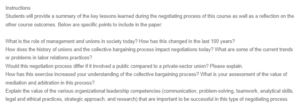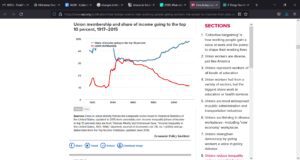Summary of Labor Relations Principles
Role of Management and Unions in Society
Unions are responsible for representing the workers in American society by being their voice. At least one in nine American workers are part of a union. This means that at least sixteen million individuals in the country are represented by unions. When employees join unions, they are confident that they have gained a voice in the workplace. The collaboration of employees in a union adds more strength to their opinions and eliminates any likelihood for their employers to ignore them. The voice of employees in a union is so strong that employers tend to seek control by using non-union channels, which do not play a role in highlighting the employees’ opinions (Wright, 2011).
The ability to speak up consequently increases democracy in the workplace. When debates surrounding work policies come up, employees can contribute or defend their position through the trade unions that represent them. This representation is compliant with the right of association and the ability to initiate or demand change. The unions have played a significant role in ensuring that the economy gains fairness by bringing to the table the employees’ plight. One of the notable changes includes debates around voting rights, discrimination, and housing (Bivens, Engdahl, & Gould, 2017).
With such a strong capability to drive change, unions can reduce inequality in the workplace. The National Labor Relations Act of 1935 is one such regulation that drove economic growth rapidly and fairly. Such regulations ensure that the already well-paid employees do not earn excess salaries in comparison to the subordinate staff. Luckily, the presence of unions affects the income growth for both union and non-union employees. Over the years, unions have been able to create living wages in certain professions, such as hospitality and nursing and introduce advancement opportunities (Bivens, Engdahl, & Gould, 2017).
Over the last ten decades, unions have undergone various changes. The rapid growth of labor markets between the 1950s and 1980s led to elaborate organizations. Most countries experienced increased membership of employees in various trade unions. During this period, wage-setting was a common activity that faced minimal resistance due to the expansive union membership. However, the decline of union membership began in the 1980s to 1992. This unfavorable change was motivated by the laid-back nature of politicians, overseas competition, capital flight threats, and unexpected changes in the work scenario. These factors made it difficult for unions to adopt (Wallerstein & Western, 2000).
Prior to the 1970s, employees could influence policy debates and other work-related factors much more easily. This led to the general improvement of the workplace. For instance, when the economic growth, which was driven by the National Labor Relations Act of 1935, stalled in the 1970s, the result was an increase in salaries for high-level employees.
Source; (Bivens, Engdahl, & Gould, 2017)
This change was represented by increasing inequality and stalling economic growth for middle-class Americans. This confirms the reduction in Union membership to date, which is consistent with the employee’s decreasing ability to voice opinions at their workplaces, as shown in the image above (Bivens, Engdahl, & Gould, 2017).
Historical Precedents and Current Trends
According to the International Labor Organization (ILO), collective bargaining is regarded as a fundamental right. Collective bargaining provides an avenue for employers, organizations, and trade unions to establish favorable working environments and fair remunerations. It also facilitates sound labor relations. Issues that are commonly addressed through collective bargaining include working hours, safety, occupational health, training, wages, and equal treatment. The main goal is to arrive at a collective agreement, which governs the employment’s terms and conditions (International Labour Organization, 2021). The trade union’s ability to utilize lobbying and advocacy to ensure that employees’ rights are observed in the organization has a significant impact on current negotiations (Morris, 2012).
One of the notable impacts on current negotiations is the default use of collective bargaining. Trade unions and employers rely on the mechanism to arrive at a favorable for all parties. However, collective bargaining can only occur if an employer acknowledges the trade union that seeks to represent employees in negotiations. The decreased union membership is one of the factors that has provided employers with the liberty to recognize trade unions and submit to voluntary collective bargaining (International Labour Organization, 2021). Only a few companies agree to use collective bargaining. These include entities that appreciate the benefits of union representation. However, a considerable number of employers evade collective bargaining because they assume that it offers employees too many options.
Labor relations are currently affected by upcoming trends. Since the beginning of the Covid-19 pandemic, employees have embraced the flexibility of work arrangements. The adoption of flexible work arrangements has occurred in all sectors. These adoptions include working from home, compressed work hours, flexible schedules, and different policies. These arrangements challenge the current labor relations, which are used to regular 40-hour working weeks (SHRM, 2021). The new trend highlights the need for the inclusion of such work arrangements in employment contracts.
Labor Relations as a System
The negotiation processes in the public and private sectors differ. In the public sector, political, as opposed to economic leverage, is employed chiefly for the collective bargaining process. When employees in the private sector stage industrial action, they intend to pressure the employer to address their issues. This action directly affects the employer’s productivity due to the unavailability of the workforce. As a result, the employer tends to submit to the demands of the employees or initiate a negotiation toward a favorable end. The economic losses that are associated with industrial action and unfavorable negotiations push the employer to settle (Kowal, 2011).
The public sector case is different since industrial cation barely affects the government. The unions that represent employees in the public sector are aware that such industrial action hurts the public services’ dependents and not the government. The pressure that builds when public sector industrial action is staged is driven by political factors (Kowal, 2011). In the public sector, winning is purely political and leads to a lack of democracy.
For instance, Mugford v. Mayor and City Council of Baltimore (1945) ruled that it was impossible for the municipality to bargain collectively because the city authorities were forbidden from delegating issues related to labor relations. Nutter v. City of Santa Monica (1945) overturned a ruling that was upheld by a lower court. The lower court’s ruling had permitted city workers to engage in collective bargaining. However, the new ruling stated that public officials’ authority cannot be delegated to others because it is important in controlling public property. These court cases and rulings confirm that negotiations in the public sector are not democracy-oriented and are driven by political instead of economic agendas (Kowal, 2011).
Collective Bargaining Process
The course’s initial milestones have highlighted critical aspects and processes of collective bargaining. Completion of the exercises has enlightened me about the collective bargaining process and its role in the negotiations that govern labor relations. I understand the different impacts that labor unions have had in the past and the influence these implementations have had on safety, equal pay, fair treatment, and the training of employees. In my understanding, labor unions have utilized collective bargaining effectively, leading to the enactment of various policies and regulations that improve the workplace and relations between employees and their employers. Unfortunately, the current changes that make it difficult to continue collective bargaining, such as reduced unionizations, are likely to reintroduce some of the negative aspects that had been eliminated in the past (Wallerstein & Western, 2000).
Collective bargaining depends on mediation and arbitration efforts for success. The mediation and arbitration efforts are critical because they introduce a neutral party with non-partisan interests. This creates a neutral ground for negotiation. The value of arbitration and mediation is significantly recognized during conflict resolution. The warring parties are usually in a mental state that does not allow for rational thinking. Thus, a mediator or arbitrator is appointed with parties’ consent to highlight the fundamental issues and help both parties to find a solution. The collective agreement is still determined by the warring parties once they agree on the key issues and feel that their interests have been addressed. This approach reduces the time that is consumed during collective bargaining and improves the quality of the collective agreement, which readily addresses the interests of both parties equally and fairly (Ibsen, 2019). Thus, mediation and arbitration efforts add value to collective bargaining processes, which push for the desired changes in the workplace.
Organizational Leadership Competencies
Organizational leadership competencies such as communication, problem-solving, teamwork, analytical skills, legal and ethical practices, strategic approach, and research are important to any type of negotiating process. Communication is the most basic and occurs in non-verbal, verbal, and written forms. All these forms of communication are utilized in the collective bargaining process to express the parties’ interests, concerns, and opinions. Oral communication allows the two parties to discuss pertinent issues and arrive at a conclusion, which is then written down for documentation purposes. During the brainstorming process, problem-solving, analytical, legal, ethical, and strategic aspects are incorporated. The employers and labor unions consider all the above aspects to ensure compliance with regulations without placing the organization’s ability to compete at risk. The collective agreement is dependent on the teamwork of both parties despite their varying opinions. Research is conducted prior to these negotiations to establish the legal and ethical practices that could affect the final collective agreement. Each party conducts in-depth research to use as arguments during the brainstorming process. The process of research enriches the discussions as each party provides their perspective, which is different from the other’s (Morris, 2012). Therefore, the organizational negotiations that take place during collective bargaining encompass all the competencies that have been mentioned. Communication holds significant value because it paves the way for the application of other competencies.
References
Bivens, J., Engdahl, L., & Gould, E. (2017). How today’s unions help working people. Economic Policy Institute.
Ibsen, C. L. (2019). Conciliation, mediation and arbitration in collective bargaining in Western Europe: In search of control. European Journal of Industrial Relations, 7(1). doi:https://doi.org/10.1177/0959680119853997
International Labour Organization. (2021). Collective bargaining and labour relations. Retrieved from International Labour Organisation: https://www.ilo.org/global/topics/collective-bargaining-labour-relations/lang–en/index.htm
Kowal, T. (2011). The Differences Between Public and Private Sector Unions. Retrieved from California Policy Center: https://californiapolicycenter.org/the-differences-between-public-and-private-sector-unions/
Morris, R. L. (2012). New Issues in Collective Bargaining.
SHRM. (2021). Labor Relations Panel Trends Report. Retrieved from https://www.shrm.org/membership/volunteers/special-expertise-panels/pages/labor-relations-panel-trends-report.aspx
Wallerstein, M., & Western, B. (2000). Unions in Decline? What Has Changed and Why. Annual Review of Political Science, 3, 355-377. doi:https://doi.org/10.1146/annurev.polisci.3.1.355
Wright, C. F. (2011). What role for trade unions in future workplace relations? doi:10.13140/RG.2.1.1147.6323
ORDER A PLAGIARISM-FREE PAPER HERE
We’ll write everything from scratch
Question

Summary of Labor Relations Principles
Instructions
Students will provide a summary of the key lessons learned during the negotiating process of this course as well as a reflection on the other course outcomes. Below are specific points to include in the paper:
What is the role of management and unions in society today? How has this changed in the last 100 years?
How does the history of unions and the collective bargaining process impact negotiations today? What are some of the current trends or problems in labor relations practices?
Would this negotiation process differ if it involved a public compared to a private-sector union? Please explain.
How has this exercise increased your understanding of the collective bargaining process? What is your assessment of the value of mediation and arbitration in this process?
Explain the value of the various organizational leadership competencies (communication, problem-solving, teamwork, analytical skills, legal and ethical practices, strategic approach, and research) that are important to be successful in this type of negotiating process.


